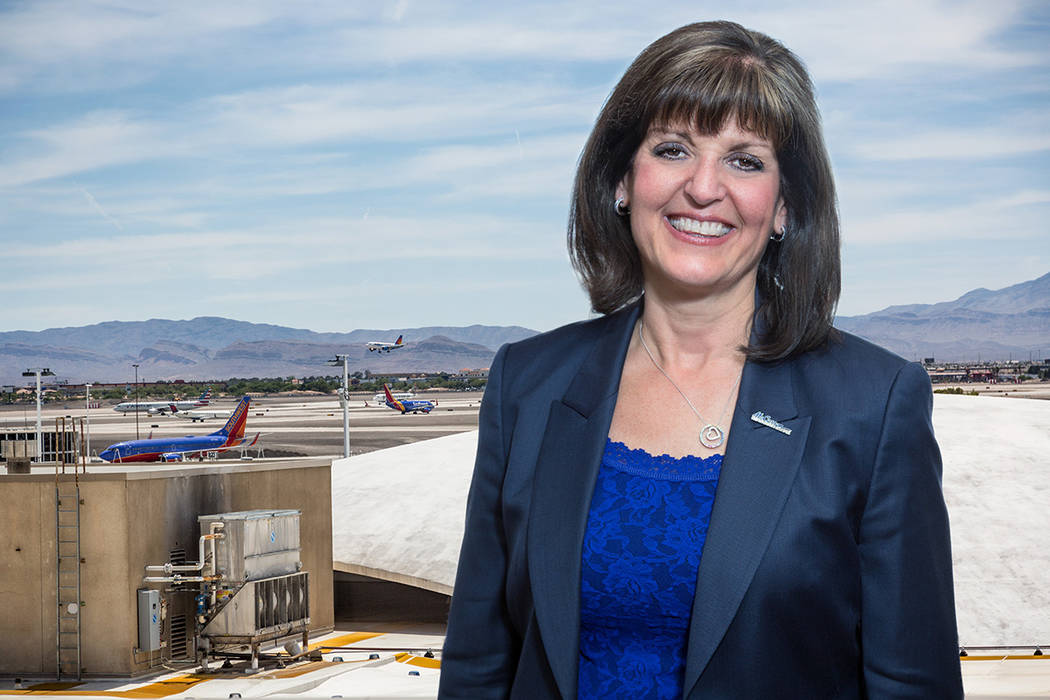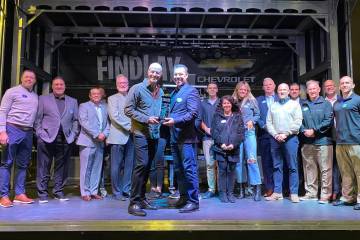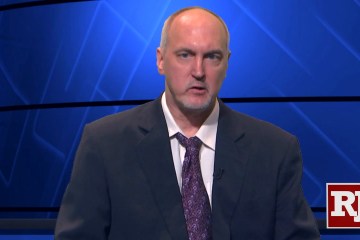
Rosemary Vassiliadis is in charge of a city onto itself: McCarran International Airport.
The 60-year-old Vassiliadis is director of the Clark County Department of Aviation, moving up from deputy director when Randy Walker retired in 2013.
In 2017, McCarran has 29 carriers, 18 of which are foreign flag with 409 international flights a week. It serves 150 markets, of which 33 are foreign cities and 117 are domestic.
Q: McCarran is the eighth-busiest airport in the nation but second-busiest airport in the nation in originations. What does that mean for Las Vegas?
A: That is what we tell everybody for staffing need — the TSA (Transportation Security Administration) and customs and border protection. It’s very powerful and true. Eighty percent of our 47 million-plus use every part of the facility. It’s not like Atlanta that does the transfers. They don’t use the curb. They don’t use the roadway system. They don’t use ticketing. They don’t use the checkpoint. We have to be concerned about … every part of our airport.
Q: What kind of impact does McCarran have on the Las Vegas Valley?
A: It’s a little city. It truly is. (Applied Analysis Principal) Jeremy Aguero called us the No.1 asset in the community. Our role is very important. We have to take it very seriously and we want to make it seamless as possible. It’s important we keep our rates and charges low because this a discretionary city and the airlines will want their yield on each and every flight.
Q: Why is McCarran so valuable?
A: We bring in almost 50 percent of the No. 1 industry that Southern Nevada holds, which is convention and tourism. We’re the conduit. They’re going to come, and I hope we make it a pleasant experience.
Q: What kind of impact do you have with jobs?
A: We are the Department of Aviation. We have 1,500 positions. The rest of the airport is another 16,000 jobs, and there is the byproduct of the people that service deliveries. I’m very proud of that. That makes a big difference in this community.
Q: What international service just started, and what is coming?
A: Aerowings just started nonstop service from Cologne, Germany. Condor added service from Frankfurt, Germany, in May. Qatar Airlines announced service from Doha in 2018. A lot of that is dependent on the aircraft because everyone is getting the Dreamliner now. It’s behind in getting delivered to the airlines. The carriers we’ve been getting like Hainan, Norwegian, Interjet and Aerowings are the low-cost carriers and not the legacy carriers. That’s what works here. It’s a good fit.
Q: What about other airlines starting new service to Las Vegas?
A: We do have interest. There’s nothing like competition. Once you see an area of the country, you know there are other discussions going on. No one wants someone to be dominant.
Q: Is Las Vegas a Western hub?
A: No. We’re not a hub. What we tell everyone is we want to be your gateway. We want to be a Western gateway. We want you to start your U.S. visit here, especially if it’s West Coast, which everybody loves. There is so much to see. Instead of flying into L.A. and going to Disneyland first, fly into Vegas.
Q: What improvement projects are underway at the airport at this time?
A: We’ve just been concentrating on upgrading Terminal 1. The airlines and concessions pay for everything. The airlines have to approve our budget along with the county since we’re a county department. When the airlines approved Terminal 3, they said they’d approve it as long as we did something with Terminal 1.
Q: What are you doing?
A: What we’re doing is modernizing Terminal 1. It looked like a 1970s casino, and we matched the improvements with the explosive-detection baggage inline project that was going on. We were one of the first airports to go inline. Back after 9-11, every airport had semi-truck-sized machines in the front. The TSA approved a total rehab of the equipment because 14 years is a long time in technology. When TSA took that node down, we took that portion of the ticket counter down. We didn’t have to impact the airlines or our customers twice.
Q: What is happening?
A: In doing that, you see what’s transforming. We’re really proud of it. We replaced all of the carpet with terrazzo flooring and made it much more colorful just like the casinos, which everybody loves. What we are looking at is to start the Vegas experience as soon as you get here and keep it going until you leave. The natural light coming in and all of the upgraded technology from the kiosk machines to the counters and how your luggage is weighed. We wrapped all of the columns. There used to be a natural cement, and now you see the white and the silver. The airlines have been pleased. It has been going well.
Q: What is the cost and timeline?
A: That is $50 million in total at Terminal 1. It will be done by the end of the year, maybe by November.
Q: Do you try to make McCarran look different than other airports across the country?
A: We do, and we have been successful. When we did Terminal 3 — the brand-new international facility — when you go (to) other airports, you see the message screen with the agent telling you what to do. We said people are coming to Vegas, and could we do it Vegas style? We had to go Washington, D.C., but we got it approved. If you see our welcome message, it is phenomenal. It shows the properties, and it has “Welcome to Las Vegas” in different languages. It’s a whole Vegas-themed message that tells you what you need to do and documents it Vegas-style. We couple it with all the beauty we have. They love Red Rock. They love the Grand Canyon and adventure-type of activity that has sustained such popularity.
Q: What are future plans to accommodate growth?
A: We do have a second commercial airport. We nicknamed it Ivanpah because it’s in the Ivanpah Valley, 5 miles north of the state line off Interstate 15. We are preserving it. We have restricted airspace here at McCarran. The reason we have it is because we butt up against the Department of Defense at Nellis Air Force Base.
Q: What is the timeline for McCarran to reach capacity?
A: It is so hard to give you a definitive number for our capacity because things just always change. Airlines have put more seats in planes, as we all know. Southwest had the 737, and they had 137 seats per aircraft. Now, we have almost 100 percent of their (planes) are 173 seats per aircraft. They’re about 200 flights a day on the low end, and they go up to 225 flights a day. What we do is look at the number of hotel rooms. There are about 151,000 hotel rooms, and the properties are going to fill those hotel rooms. We do a regression analysis and it’s about 260 to 270 passengers per room. We think we have enough capacity for about 30,000 more hotel rooms.
Q: How long will that last?
A: We think we probably have 20 to 25 years when we look at what has been happening and how the Strip has been reacting. They’re reinventing themselves other than sprawling to the south. I don’t think we’re going to see that like we did in the late 1990s and early 2000s. We have gate capacity and ramp capacity and parking capacity for airplanes that stay overnight. We’re in good shape right now.
Q: What is happening with TSA screening at McCarran?
A: I don’t think we exceed any standard on our screening. We work very hard on that. We’re the first and last look of Las Vegas. We want everyone to come back at least one more time within the year. We don’t (want) any of the process to be an obstruction to their decision-making. We have to have TSA dogs here and that allows a different level of how you flow through. You go through the dog (check) a couple of times, and then you are treated like a precheck customer. We very rarely exceed 45 minutes to an hour during a peak time. Other than that, I don’t think it’s like five minutes.
Q: What are your thoughts on President Donald Trump’s proposal to make air traffic control a nonprofit entity?
A: We have not weighed in on that. We have a tremendous relationship with our tower and the FAA (Federal Aviation Administration) team here in Las Vegas. It’s not an issue we need to be vocal on.
Q: What is the biggest challenge you face in your job?
A: My biggest challenge and fear is any type of terrorism event, now that it’s spreading to domestic terrorism and single-cell type of terrorism. That is always a constant worry, and we will do everything we can to deter it here. You see these incidents across the nation, and it’s very worrisome. We’re a discretionary location, and people have to want to come here. It’s not like New York or Chicago or L.A. where you have to go through those airports. They don’t have to come here. You want everyone to feel safe.
Q: If you can wave a magic wand and make changes at McCarran, what would you do?
A: One thing we are going to change is our roadway system. If (we) had little powers and magic fairy dust, I would figure out a way for pedestrians to go across the traffic lane where taxi cabs are. We’re working on that one. We just got approval from the board to negotiate a contract to look at (the) roadway system in its entirety. My goodness. It was built in 1970. We’re a little bit different today.
Q: What are your future plans?
A: I want to be here as long as the board of (Clark) County commissioners will have me here. There is a lot to do. I hope my experience lends a hand to make it a better experience. Las Vegas is known for its hospitality, and that’s something we have been interjecting in every part of the airport. It keeps on changing. That is the wonderful world of aviation. That is what’s so exciting about this industry, and I am totally bitten. I hope I’m staying.






